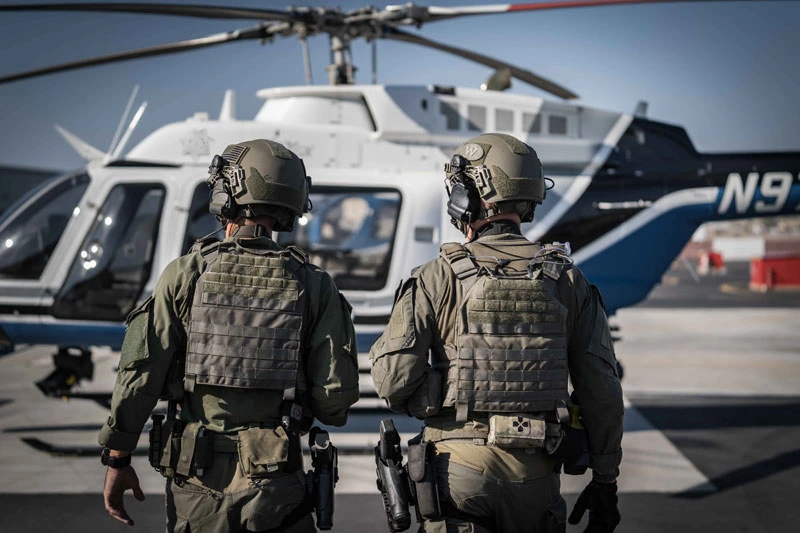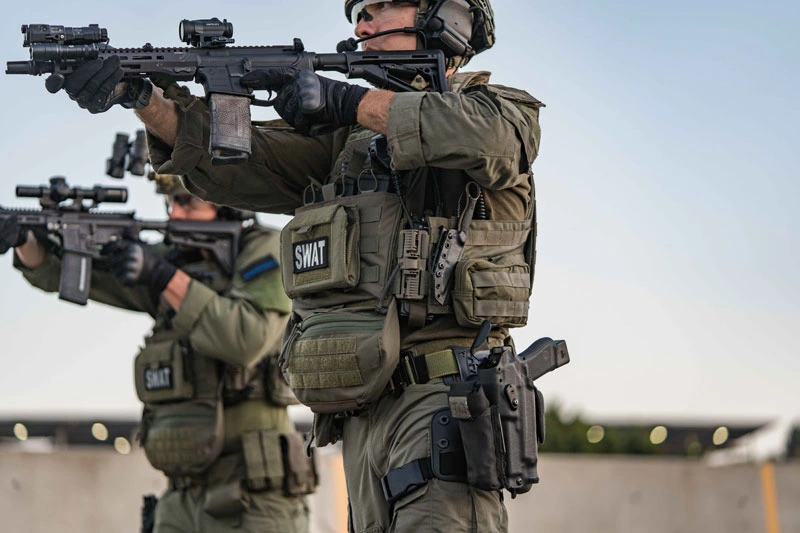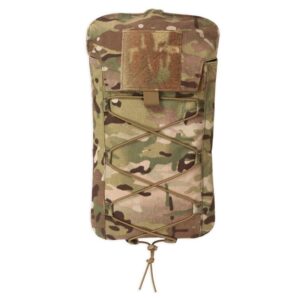Waterproof vs Water-Resistant: Best Tactical Backpack?

When you enter the unknown—like a backcountry trip, a military operation, or a long outdoor adventure—the backpack is more than just a way to carry your gear. It’s your rolling home base. That’s why one of the most contentious questions in tactical use is: Do you go for a waterproof or water-resistant backpack?
These two words can be used interchangeably, but they’re at quite different levels of protection. And when you’re counting on your gear in harsh, unpredictable conditions, getting the right one can mean the difference between easy sailing and a gear-busting catastrophe.
Explore mission-ready backpacks built for performance at Chase Tactical.
What Is A Waterproof Backpack?
A waterproof backpack employs materials such as PVC, TPU-coated nylon, or high-denier ripstop fabric with welded or heat-sealed seams. Such bags usually have roll-top closures, watertight zippers, and minimal stitching to minimize any chance of seepage.
The key promise of a waterproof backpack is that no water gets in. Everything inside stays bone dry, whether caught in a downpour, wading through rivers, or accidentally dropping your pack in a lake.
Situations That Require Waterproof Backpacks
Maritime or amphibious missions: If you’re close to bodies of water, your equipment will get splashed, submerged, or soaked.
Heavy rain areas include Southeast Asia, the Pacific Northwest, and the rainforest.
Snow missions: Wet snow can be as bad as rain if it melts into your equipment.
Sensitive electronic transport: Drones, radios, laptops, or camera equipment need to remain dry at all costs.
What is a Water-Resistant Backpack?
A water-resistant backpack, however, provides fair protection against water. It’s usually constructed of treated materials such as DWR-coated nylon or polyester, which repel light rain or splashes. These packs tend to resemble more normal-looking packs with zipper enclosures and normal stitching.
Though they can withstand fast showers or morning dew, they’re not designed to endure submersion or prolonged exposure to water.
Situation Where Water Resistance May Be Enough
Urban or desert missions: Brief bursts between structures, desert environments, or altitudes where rain is rare.
Short-term exposure: You trust you can get undercover or bring rain gear if conditions get wet.
Weight-sensitive missions: Waterproof bags are often lighter and more compressible.
What Methods are Employed by a Manufacturer to Attain Water Resistance in a Backpack?
Tactical double backpack compartments water resistant are designed for durability and functionality, making them ideal for military grade hiking and survival enthusiasts. The best waterproof survival backpacks utilize advanced materials for effective water resistance.
- DWR Coatings: These factory-applied treatments cause water to bead up on the fabric surface, typically used on 500D or 1000D Cordura® nylon. However, they don’t seal seams or zippers and can degrade over time. Reapplication with aftermarket sprays can help maintain effectiveness.
- Tight-Weave Fabrics: High-denier nylon or polyester, especially with ripstop weaves, slows water penetration. While not completely waterproof, they offer better protection in rainy conditions and greater durability against wear and tear.
Tactical backpacks are available in various sizes and feature adjustable straps, breathable shoulder straps, and pockets for better storage and comfort during travel. A rugged, lightweight design lets you carry tons of gear, including essential supplies for an emergency situation, food, and other survival essentials.
What Factor Should You Consider Before Buying A Tactical Backpack?
When considering tactical use, consider your mission profile. Are you a military member performing search and rescue, backpacking in monsoon areas, or just someone who enjoys off-grid adventure? Your environment greatly impacts whether waterproofing or water resistance is sufficient.
Limitations of Waterproof and Water-Resistant Backpacks
While water-resistant and water-proof backpacks offer great protection against light rain and moisture, there are some limitations to consider:
- Water-Resistant Backpack Limitations:
- Not Fully Waterproof: Water-resistant materials and coatings, such as DWR, prevent water from soaking in to some extent, but they do not make the backpack fully waterproof. Prolonged exposure to heavy rain or submersion in water may still result in leakage.
2. Waterproof Backpack Limitations:
- Zippers and Seams: Even waterproof backpacks cannot guarantee complete protection if zippers or seams are not fully sealed. Some manufacturers include waterproof zippers or tape-sealed seams to mitigate this.
- Weight and Bulk: Waterproof backpacks tend to be heavier due to additional layers of material, heavier padding, or waterproofing technologies, which can impact overall comfort during long hiking trips or camping expeditions.
Comparison Points Of Waterproof And Water-Resistant Backpacks

Selecting a waterproof versus a water-resistant tactical backpack is more than just its ability to repel water. Consider durability, access speed, compatibility with modular design, and weight. Let’s examine how these two backpacks compare in the field, based on actual tactical performance.
1. Durability
Waterproof backpacks are durable and more rugged thanks to their thicker, coated fabric and seam-sealing technology. However, this toughness may come at the expense of increased weight and decreased flexibility.
Less impermeable, water-resistant bags are usually lighter and more agile, which can benefit high-speed tactical operations.
Waterproof for durability and protection, and water-resistant for agility and lighter loads.
2. Closure Systems
Waterproof bags often rely on roll-tops or airtight zips. These are great at keeping water out but are a bit slower to get into, which is important in high-pressure environments.
Water-resistant bags use standard zips and flaps, which are quicker to open but more prone to rain.
Water-resistant may have the edge if speed is more important than 100% dryness. If you’re wading across rivers, nothing surpasses a roll-top.
3. Maintenance & Flexibility
Waterproof bags require more special attention to retain their coating and seam integrity in the long term. Some materials will become brittle at freezing temperatures or stiffen with age.
Water-resistant bags are simpler to clean and maintain, and their rubbery material supports more compartmentalized organization and daily use. Be waterproof if you’re willing to do the gear maintenance; be water-resistant if you prefer less hassle.
4. Cost Consideration
Waterproof bags cost more because they use high-quality materials and construction methods.
Water-resistant bags are a good value for tactical users who don’t require full submersion protection.
Waterproof is an investment; water-resistant is budget-friendly and more versatile for non-aquatic environments.
5. Tactical Gear Compatibility
This is where the discussion becomes interesting. Because of their minimalist, seal-friendly construction, waterproof packs tend to have limited MOLLE or accessory options. Conversely, water-resistant bags include MOLLE webbing, hydration ports, and attachment points, which are more prevalent in tactical systems.
If expandability and modularity are requirements, water-resistant options might be a better fit for your loadout.
Final Verdict: Which Is the Best Backpack?
Regarding tactical applications, deciding between a waterproof and a water-resistant backpack comes down to your mission environment and what’s most important to you. If you’re in wet, unpredictable environments—jungles, coastal areas, snow country—a waterproof pack offers superior protection and peace of mind, particularly when carrying sensitive electronics or dry clothing.
However, a water-resistant pack is more practical when prioritizing speed, mobility, and modularity in drier or urban environments. It’s easier to access, lighter, and more smoothly integrated with tactical equipment such as MOLLE systems and hydration packs. When you require the best of both worlds, a hybrid solution—employing a water-resistant pack with waterproof compartments or dry bags—can offer balanced protection without sacrificing versatility. Finally, the ideal backpack assists your cause without compromise.
Frequently Asked Questions
Can I waterproof a water-resistant backpack with a cover?
Yes, including a rain cover or internal dry bags can add protection, but it won’t provide the complete waterproofing of a sealed pack.
Are waterproof backpacks always heavier?
Typically, yes. Waterproof materials and sealing technology weigh more. However, some new models are lightening up without sacrificing durability too much.
What is best for storing electronics in a tactical environment?
A waterproof backpack or a waterproof compartment/dry bag is best. Delicate electronics are extremely susceptible to even a small amount of water.

